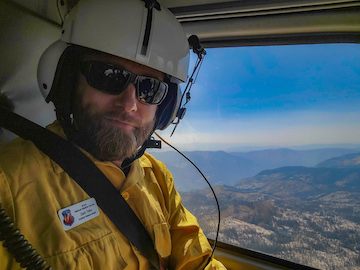NOAA names first manager of new Fire Weather Testbed
.jpg)
 Zach Tolby, formerly a Senior Forecaster and Incident Meteorologist (IMET), at the Reno, Nevada Weather Forecast Office, was recently selected to be the first Manager and Lead Scientist of the Fire Weather Testbed, which is housed in the Global Systems Laboratory’s Boulder, Colorado offices.
Zach Tolby, formerly a Senior Forecaster and Incident Meteorologist (IMET), at the Reno, Nevada Weather Forecast Office, was recently selected to be the first Manager and Lead Scientist of the Fire Weather Testbed, which is housed in the Global Systems Laboratory’s Boulder, Colorado offices.
Tolby has over 12 years of operational forecasting experience, including working as an IMET on the front lines during two of California’s most active wildfire seasons in history. He also has a background in science communications research and is passionate about improving the communication of complex weather forecasts provided to decision-makers and the public.
“Zach has a strong background as a lead forecaster and an IMET,” said Dan Nietfeld, the Lab’s Chief of the Weather Informatics and Decision Support Division, “He’s worked a lot of big California fires and has tremendous networking experience.”
The Fire Weather Testbed is the most recent addition to the Weather Program Office’s suite of 12 testbeds and Proving Grounds, designed to allow researchers and forecasters to evaluate and improve new technologies and systems to evaluate their potential for transition into operations. The new testbed will be a collaborative partnership between Global Systems Laboratory, the National Weather Service and the National Environmental Satellite, Data, and Information Service (NESDIS). The goal of the Fire Weather Testbed is to move advanced models, information, technologies, and applications to operational use as quickly as possible.
IMETs serve as the primary source of tactical weather and climate information during major wildfires, briefing Incident Management Team leaders, firefighters, U.S. Forest Service officials, utility managers, and state and local officials multiple times a day with hyper-local forecasts on fire weather. The information they provide supports decisions about where and when to safely deploy firefighters and equipment, issue evacuation notices, and plan the complex logistics required to fight large wildfire incidents.
Among the big fires Tolby saw first-hand were the Creek Fire, which burned 380,000 acres in the central Sierra Nevada Mountains near Fresno in 2020, the Monument Fire, which burned more than 223,000 acres and more than 800 structures in Northern California during the summer of 2021, and the Caldor Fire, which burned 221,835 acres and destroyed more than 1,000 structures in the Sierras near Lake Tahoe soon after.
In addition to his operational experience, Tolby co-founded an interdisciplinary research group with the University of Nevada-Reno, the Desert Research Institute, and Arizona State University. The group focuses on social and behavioral science research combined with atmospheric science research to investigate topics such as communicating probabilistic information to enhance decision support.
“I spent much of 2020 and 2021 out on fires, and I’ve had a lot of experience working directly with people on the ground,” Tolby said. “I’m looking forward to helping move the needle forward in the fire weather realm.”
